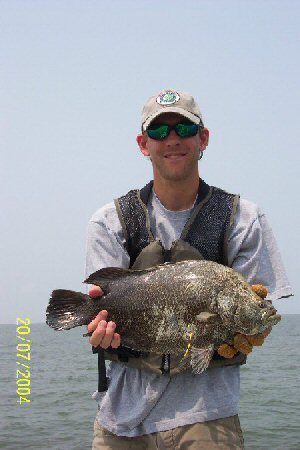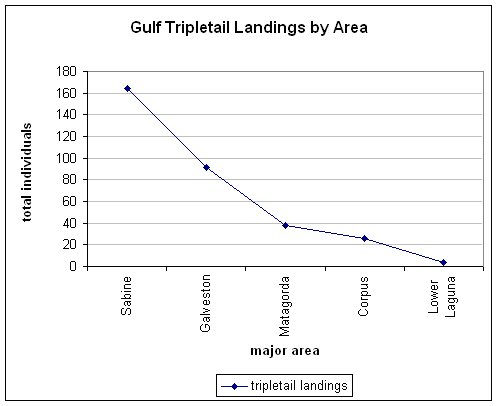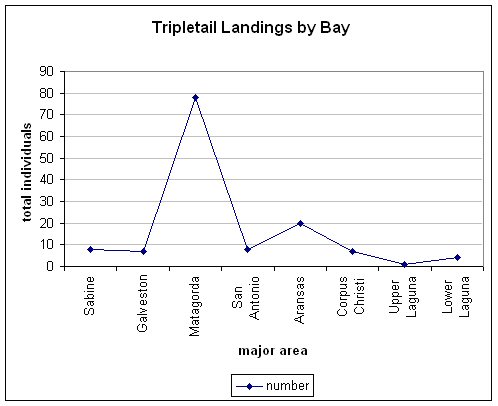Tripletail, A Weirdly Wonderful Fish
Bill Balboa, Matagorda Bay Ecosystem Leader
I have been fascinated with tripletail since my first encounter with this bizarre fish back in 1988. I was a neophyte Texas Parks and Wildlife Fish and Wildlife Technician working at the Palacios field station and we were motoring down the ICWW when I spotted what appeared to be a piece of black plastic floating on the water’s surface. Motivated to do the “environmentally correct” thing we turned the boat around. As we idled towards the offending litter, the plastic suddenly came to life, and disappeared below the surface. A subsequent discussion, with the station's biologist, about this puzzling instance, revealed that what I had seen was, most likely, not litter at all but a large tripletail floating on the surface.
Tripletail, Lobotes surinamensis, are a cosmopolitan species; documented from the Pacific Ocean off California to Nova Scotia, but they most often occur in tropical and temperate waters throughout the globe. They are the sole representative of the family Lobotidae and, contrary to popular belief, are not related to grouper or any other species found along the Gulf Coast.

Juvenile tripletail, 1/2” — 1”long, can often be seen along bulkheads and shorelines, near Gulf passes. Resembling small leaves floating on the surface, they are multicolored mottled with black, brown and gold. As they mature and grow, some retain a mottled appearance, most commonly seen in adult tripletail offshore, but the majority change to a dark gray, black or a deep bronze color. Little academic research has been conducted on the life history or biology of this species but recent investigations have concluded that tripletail mature at one year (about 12”) and spawn offshore with peak spawning occurring during July. Larval tripletail are most often collected offshore in water depths of > 210 feet. In the Gulf of Mexico, tripletail migrate to the nearshore Gulf and estuaries during April – October – a migration that Texas appears to be related to rising water temperatures.
The most characteristic and certainly one of the most unusual behaviors exhibited by these fish is the propensity to lie just below the surface, floating with one side exposed, looking for all intents, dead. It was this trait that lead me to believe, back in 1988, that what I had seen floating on the surface was a piece of black plastic. To my knowledge, there has been no scientific evaluation of why tripletail behave in this manner. I suppose it is not unreasonable to speculate that this trait may relate to either thermal regulation or as a feeding strategy as they “lie in wait” for an unsuspecting prey item to assume a position under their floating bodies. The latter seems the most feasible since tripletail are often found near weed lines and many of their prey items would naturally be fish or invertebrates that associated with floating structures
Tripletail are most often seen and caught near structure (platforms, pilings et.) and floating objects (flotsam, sargassum rafts etc.). It is this affinity that makes tripletail a relatively easy target for anglers. It is merely a matter of locating structures or “weed lines” holding tripletail, placing appropriate bait near the waiting fish, and then the action begins. The biggest obstacle to landing these fish is trying to pull them away from pilings or other obstacles before they wrap or tangle the line and break-off.
Tripletail are popular game fish in all Gulf coast states. In other states, tripletail are often referred to as “blackfish” and are a popular and fairly well known game fish. In fact, some Gulf states even allow limited commercial harvest of the species. The flesh is firm, white and, is considered by many to be equal to or superior to red snapper or grouper.
In Texas, tripletail are found in all nearshore Gulf and estuarine environs. However, there are a few areas, along the Texas coast, where tripletail are most abundant. In the Gulf of Mexico, TPWD Coastal Fisheries recreational harvest data indicate that the nearshore Gulf off Sabine Lake is the Gulf area, that produces the most tripletail. The Gulf off Galveston and Matagorda are second and third highest producers (Figure 1). In Texas bays, however, West Matagorda Bay is where most tripletail are usually caught by recreational anglers and in TPWD gill nets (Figures 2 and 3). Why Matagorda Bay is so appealing to tripletail is a mystery. Perhaps it is a combination of the number of pilings and platforms and the salinity regime.
The largest tripletail documented in the TPWD fisheries database was almost 37-inches long and was landed by an angler fishing in the Gulf of Mexico. If the information is accurate, this tripletail would have beaten the current State record of held by Mrs. Eddie Porter of 34 inches and 33lbs. 8oz. caught in West Matagorda Bay in 1984. Tripletail this large are not common, with most tripletail landed by anglers or caught in TPWD‘s samples averaging about 19” – 20” long.
Currently, staff in Matagorda Bay are conducting a tagging study of tripletail to increase our knowledge of the movement and life history of the species in Texas. The project began last summer and so far we have received two returns (both captured within 4 miles of where they were tagged) from 24 tagged individuals. The study continues this summer and we ask that anyone that catches a tagged tripletail provide the nearest TPWD office with the location, the length, the date and the tag number. We use internal anchor tags with a unique serial number printed on both the orange anchor (placed inside the fishes gut cavity) and the yellow streamer which protrudes from somewhere along the fishes flank. If the fish is too small to keep, the number should still be visible on the streamer. We appreciate any and all information we receive.
Actually a few Gulf States have bag and size limit restrictions on tripletail harvest, although Texas does not. Additionally, tripletail have been receiving a lot of attention in fishing magazines and newspapers. Consequently, more people are coming to Matagorda Bay in search of this fish and subjecting the species to increased fishing and harvest pressure. So, therein lies the quandary. Is it ethical to find structure or weed lines holding lots of tripletail and keep as many as you can land, or only retain a few and leave the rest. Since we do not know much about the life history of this bizarre fish or the size of the resident tripletail population in Texas’ marine waters, please utilize the resource wisely – leave some behind.

Figure 1

Figure 2

Figure 3